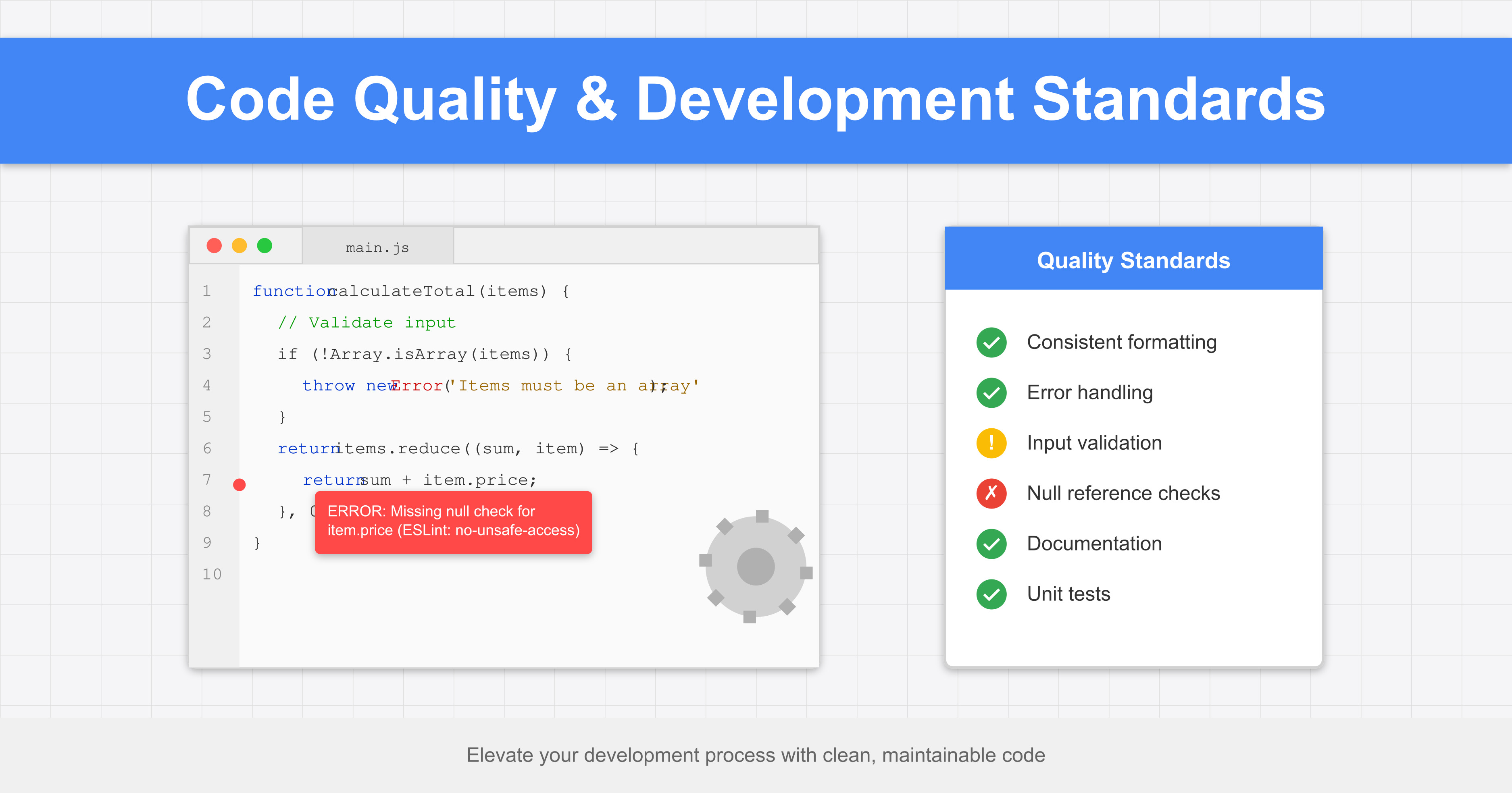Code Quality & Development Standards
Establishing and implementing coding standards and quality practices that improve maintainability, reduce technical debt, and enhance team efficiency

Project Overview
Client
Multiple Organizations
Timeline
2014-Present
Role
Various Technical Leadership Positions
Technologies
Project Summary
Established and implemented comprehensive coding standards and quality practices that improved code maintainability, reduced technical debt, and enhanced development team efficiency and collaboration.
The Challenge
Organizations struggled with inconsistent coding practices, accumulating technical debt, and difficulties in maintaining and extending existing codebases, leading to slower development cycles and increased defect rates.
Key challenges included:
- Inconsistent coding practices across development teams and projects
- Growing technical debt that increasingly hindered new feature development
- Knowledge silos and dependencies on specific developers for code understanding
- Difficulties onboarding new team members to existing codebases
- Recurring defects and quality issues that impacted release schedules
- Limited automated testing leading to regression issues
The Solution
I developed and implemented comprehensive code quality initiatives that established clear standards, improved development practices, and created sustainable processes for maintaining code health.
I developed a comprehensive solution to address all the key challenges.
Coding Standards Development
Created comprehensive coding standards that defined conventions for code organization, naming, formatting, and implementation patterns. These standards were tailored to specific technologies while maintaining consistency across the development ecosystem.
Code Review Process
Established structured code review processes that ensured all code changes received appropriate scrutiny before integration. Developed review guidelines that focused on key quality attributes and created constructive feedback mechanisms that improved both code and developer skills.
Automated Quality Tools
Implemented automated quality tools including static code analysis, linting, and automated testing frameworks. Integrated these tools into development workflows and continuous integration pipelines to provide immediate feedback on quality issues.
Technical Debt Management
Created systematic approaches to identifying, prioritizing, and addressing technical debt. Implemented incremental refactoring strategies that balanced immediate improvement needs with ongoing feature development requirements.
Development Process
Current State Assessment
Evaluated existing codebases and development practices to identify quality issues, inconsistencies, and improvement opportunities. Used static analysis tools and manual reviews to create a comprehensive quality baseline.
Standards Definition
Developed coding standards and best practices through collaborative workshops with the development team. Created living documentation that was continuously refined based on practical application and team feedback.
Tooling Implementation
Selected and implemented appropriate tooling to support quality initiatives, including IDE configurations, static analysis, automated testing frameworks, and continuous integration pipelines. Configured tools to align with established standards.
Team Training & Adoption
Conducted training sessions on new standards and tools to ensure consistent understanding across the team. Used mentoring, pair programming, and code reviews to reinforce standards application in daily work.
Continuous Improvement
Established regular quality reviews to assess progress and identify new improvement opportunities. Created feedback loops that allowed the team to refine standards and practices based on real-world experience and changing requirements.
Results & Impact
The project delivered significant benefits for the client:
- Improved efficiency and reduced processing time
- Enhanced data security and compliance
- Better user experience for staff and clients
- Scalable solution for future growth
Technical Highlights
Layered Testing Strategy
Developed a comprehensive testing strategy that incorporated unit tests, integration tests, and end-to-end tests in appropriate proportions. This approach ensured efficient test execution while providing thorough coverage of critical functionality.
Automated Code Analysis Pipeline
Implemented automated code analysis within continuous integration pipelines that checked for code style compliance, potential bugs, security vulnerabilities, and performance issues. This automation ensured consistent application of quality standards across all projects.
Documentation Integration
Integrated code documentation requirements into the development process, ensuring that all code included appropriate comments, API documentation, and usage examples. Created automated tools to validate documentation completeness and quality.
Refactoring Framework
Established a systematic framework for identifying, planning, and executing code refactoring initiatives. This approach enabled gradual improvement of existing codebases while managing risk and maintaining functionality during the transformation.
Related Content
Related Services
Web Development
Modern web application architecture and development with a focus on performance, scalability, and user experience.
Team Management
Building and leading high-performance technology teams that deliver consistent results and drive organizational success.
Technology Leadership
Strategic technology leadership to align technical decisions with business goals and drive organizational transformation.
Related Case Studies
Web Application Architecture Design
Design and development of scalable, secure web application architectures for complex business requirements
Cross-Functional Team Leadership
Building and leading high-performance cross-functional development teams to deliver exceptional results through effective collaboration
JIRA Workflow Implementation
Championed and led the implementation of JIRA workflows for efficient project management and issue tracking
Interested in working together?
Let's discuss how I can help transform your development process and deliver exceptional results for your organization.
